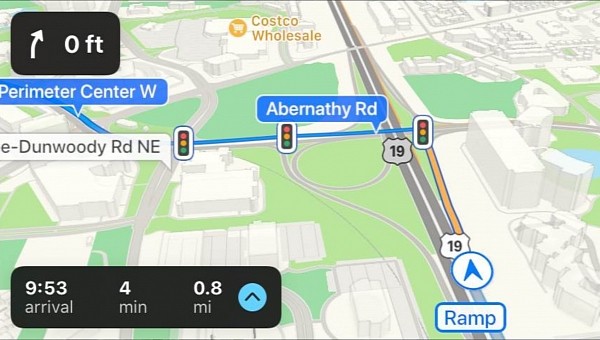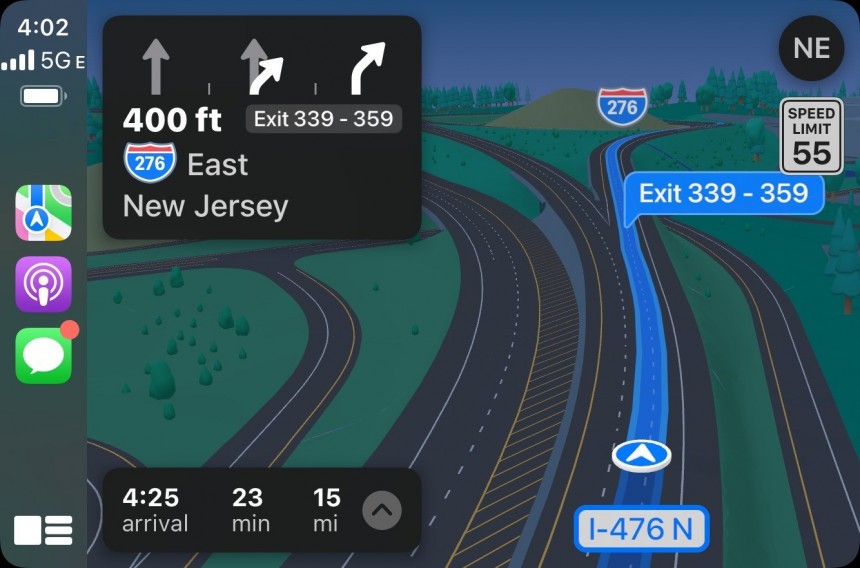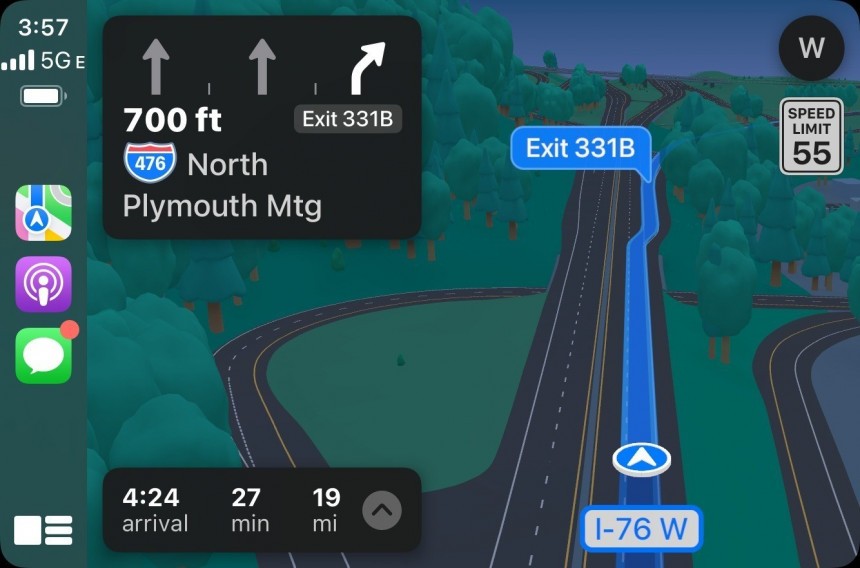Apple is one of the companies aggressively investing in mapping services, with Apple Maps currently considered one of the top alternatives to the likes of Google Maps.
Available as the native offering on iPhones, Apple Maps obviously has a very solid user base, especially as some of the company’s customers are particularly interested in sticking with first-party solutions.
But on the other hand, it’s not a secret that Apple Maps is losing ground in the area that matters the most for the end user: the feature availability. The Cupertino-based tech giant is rolling out new capabilities, such as the 3D navigation support, at an annoyingly slow pace, and at some level, it’s not even interested in accelerating the release in any way.
This is precisely why Apple Maps is losing the fight with its rivals. Recent research published by analysis firm Omdia emphasizes that the new-generation Apple Maps, which no longer uses TomTom data, is only making slow progress, therefore putting the software way behind its biggest competitors in the majority of markets.
In other words, while Apple seems committed to delivering a substantially upgraded Apple Maps experience to users worldwide, the whole thing takes way too long, and eventually, the company could just end up being late to the party.
But on the other hand, there are three things that Apple could use to build an almighty navigation app.
First and foremost, it’s the always-expanding developer community that could help improve the adoption of Apple Maps across the world. The study indicates that Apple Maps has the largest number of developers in the challengers groups (apps that aren’t currently the top solutions worldwide), and this provides the software with a significant growth opportunity.
Tech giants need developers to offer solid products, and Microsoft is just the best example on this front. The software giant’s push for its very own mobile platform failed due to lackluster developer interest, with Windows Phone eventually retired pretty much because almost nobody brought their apps to the store.
With a growing community of devs, Apple can help expand Apple Maps as well, but once again, this takes time, and the company needs to accelerate its efforts on this front.
Second, it’s the user experience that Apple is so committed to delivering. As compared to the other navigation apps out there, Apple Maps is primarily focused on high-quality content, so the service now offers 3D renderings of some of the largest cities, immersive walking directions, rich map details, and updated navigation with stop signs and traffic light locations.
All of these prove that Apple is sticking with an approach that made its other products famous: adopt an existing concept but reinvent it with a premium touch that would set it apart from the rest of the crowd.
And third, Apple’s brand loyalty could help Apple Maps in the long term. It’s not a secret that Apple’s customers are avid company fans, with brand loyalty getting close to 90 percent in both the United States and Europe.
This could help the company expand Apple Maps and grow it bigger, as many users would be tempted to stick with it despite certain shortcomings simply because it’s an Apple product.
But at the end of the day, I still believe that everything comes down to feature availability. Apple needs to accelerate the rollout and release new capabilities to users across the world at a faster pace, especially because a slow approach typically generates more frustration in the community.
For example, if users are forced to wait too long for new features, they could end up migrating to another product. Once they switch and get used to what the alternative has to offer, they may never go back, so Apple is missing a great opportunity to grow its platform both in short and the long term.
And then, using such a slow rollout for new-generation Apple Maps features gives more time to rivals to build competing products. The 3D navigation feature that Apple has developed is a fantastic update, and it has great potential to convince more Google Maps users to switch to Apple Maps. But on the other hand, the 3D future is also part of Google’s commitment to improving Google Maps, so sooner or later, Apple may no longer be the only company that’s focused on this front.
At the end of the day, as the cited research also notes, Apple has what it takes to become a top player in the navigation space, and the only thing that it needs is a good strategy on how to make this possible. For the time being, Apple doesn’t seem too committed to building an almighty navigation app, and unless it improves in this regard fast, it could end up being late to the party, and the company certainly knows this is sometimes irreversible.
But on the other hand, it’s not a secret that Apple Maps is losing ground in the area that matters the most for the end user: the feature availability. The Cupertino-based tech giant is rolling out new capabilities, such as the 3D navigation support, at an annoyingly slow pace, and at some level, it’s not even interested in accelerating the release in any way.
This is precisely why Apple Maps is losing the fight with its rivals. Recent research published by analysis firm Omdia emphasizes that the new-generation Apple Maps, which no longer uses TomTom data, is only making slow progress, therefore putting the software way behind its biggest competitors in the majority of markets.
In other words, while Apple seems committed to delivering a substantially upgraded Apple Maps experience to users worldwide, the whole thing takes way too long, and eventually, the company could just end up being late to the party.
But on the other hand, there are three things that Apple could use to build an almighty navigation app.
Tech giants need developers to offer solid products, and Microsoft is just the best example on this front. The software giant’s push for its very own mobile platform failed due to lackluster developer interest, with Windows Phone eventually retired pretty much because almost nobody brought their apps to the store.
With a growing community of devs, Apple can help expand Apple Maps as well, but once again, this takes time, and the company needs to accelerate its efforts on this front.
Second, it’s the user experience that Apple is so committed to delivering. As compared to the other navigation apps out there, Apple Maps is primarily focused on high-quality content, so the service now offers 3D renderings of some of the largest cities, immersive walking directions, rich map details, and updated navigation with stop signs and traffic light locations.
All of these prove that Apple is sticking with an approach that made its other products famous: adopt an existing concept but reinvent it with a premium touch that would set it apart from the rest of the crowd.
And third, Apple’s brand loyalty could help Apple Maps in the long term. It’s not a secret that Apple’s customers are avid company fans, with brand loyalty getting close to 90 percent in both the United States and Europe.
This could help the company expand Apple Maps and grow it bigger, as many users would be tempted to stick with it despite certain shortcomings simply because it’s an Apple product.
For example, if users are forced to wait too long for new features, they could end up migrating to another product. Once they switch and get used to what the alternative has to offer, they may never go back, so Apple is missing a great opportunity to grow its platform both in short and the long term.
And then, using such a slow rollout for new-generation Apple Maps features gives more time to rivals to build competing products. The 3D navigation feature that Apple has developed is a fantastic update, and it has great potential to convince more Google Maps users to switch to Apple Maps. But on the other hand, the 3D future is also part of Google’s commitment to improving Google Maps, so sooner or later, Apple may no longer be the only company that’s focused on this front.
At the end of the day, as the cited research also notes, Apple has what it takes to become a top player in the navigation space, and the only thing that it needs is a good strategy on how to make this possible. For the time being, Apple doesn’t seem too committed to building an almighty navigation app, and unless it improves in this regard fast, it could end up being late to the party, and the company certainly knows this is sometimes irreversible.
















